



Vehicles Books Briefing Cards Tour Equipment
Welcome to the BRIXMIS Page
The British Commanders'-in-Chief Mission to the Soviet Forces in Germany (BRIXMIS) was set up on 16 September 1946 under the Robertson-Malinin Agreement between the chiefs of staff of the British and Soviet forces in occupied Germany.
The agreement called for the reciprocal exchange of liaison missions in order to foster good working relations between the military occupation authorities in the two zones. Similar agreements were then reached the following year by the Soviets with the French (FMLM) and the Americans (USMLM).
For unexplained reasons the agreements differed significantly as the British were allowed to have almost as many liaison staff in the Soviet Zone as the other two Missions combined. The agreements remained in force until 2 October 1990 when all three missions were deactivated on the eve of Germany's reunification.
For a full history Click here to be taken to the official BRIXMIS page
BRIXMIS Tour Cars - Many different cars were used over the years, including Opel Senators, upgraded to four wheel drive, Range Rovers and finally Mercedes G Wagons.
Here are a few
photo's of a Opel Senator, carrying plate No.7, Its a very good replica,
the Owner is Pierre Flauss, the car was produced with the help of former mission
member Dave Picton, and by looking at the Senator No.1 which resides in the
National Army Museum.
All the exterior lighting system are is functional, Pierre has tried to
make it as close as possible to the real thing but the car dosen't have
fergusson formula four wheel drive..
Pierre is currently working on a Range Rover (tour - car) and a low
profile Mercedes from the FMLM. Pierre worked in the past for the French
military government in Berlin, so he had some contact with French and British
missions.
Spotted at the 2003 War and Peace Show Beltring, Kent.
And does anyone know what's hiding under this? Well I found out - it's the support of the regular French number plate, in style of the covered brigadier mission chief plate on vehicle No. 1
A few books have been written on the Liaison Missions I believe I have them all, They are all out of print apart from Commander Faheys Book
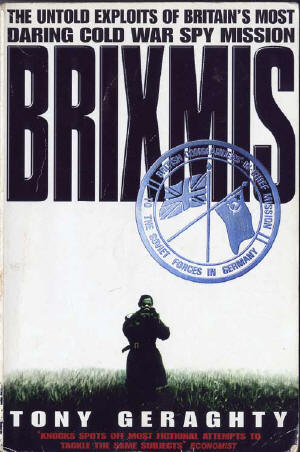 |
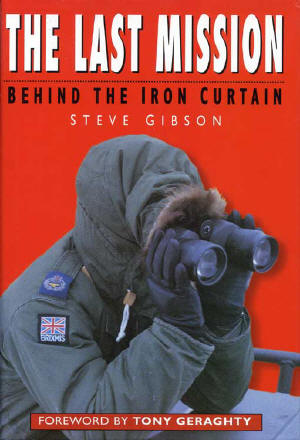 |
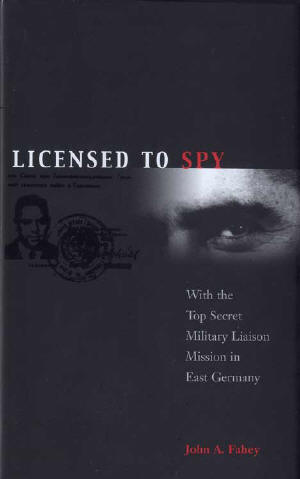 |
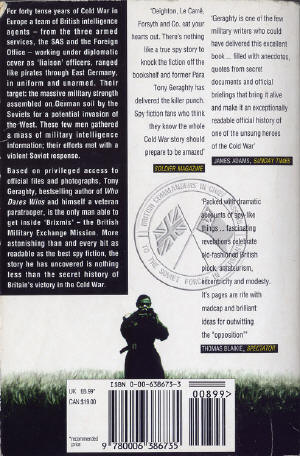 |
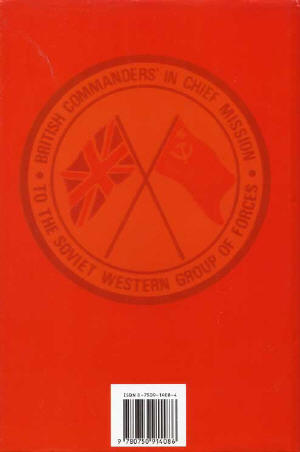 |
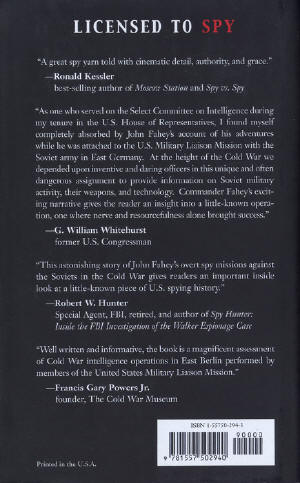 |
East German, Soviet, Mission Briefing Cards
|
||
| Sorry Lost
the photo!
|
||
|
Number plates: GSFG (Group of Soviet Forces in Germany) American / British / French military mission Text: These number plates are used by the three western military liaison missions which are accredited to the CinC, Group of Soviet Forces temporarily [1] stationed in the German Democratic Republic. They may move freely around the territory of the GDR, except in prohibited areas. They are subject to the laws of the GDR and internationally agreed arrangements. Report any sightings to the nearest Volkspolizei (People's Police) station, using the points on the reverse, to ensure that the members of the western MLM can be assured of their rights and that they act in accordance with their obligations. [1] This was politically important: Only the EGers used the word "temporarily". The Soviets didn't. At some stage, the word was removed from the text. Sorry Lost the photo!
|
||
|
1. Date, place and time of sighting. 2. Nationality and VRN (vehicle registration number). 3. Direction of travel (from / to), and on the autobahn: distance marker. 4. Number of occupants, in uniform, in plain clothes, sex. 5. Particular details: parked, using binoculars, cameras, maps, breach of the highway code, EGers near vehicle, sleeping out in the open, etc. 6. Incomplete details should also be reported. 7. Name, rank and unit of the person reporting the sighting.
|
||
|
From "The Last Mission" by Steve Gibson Tour equipment was geared firstly towards completing missions and secondly towards self-sufficiency. Inevitably the two were interdependent. There was no point going out into the DDR to undertake missions if you couldn't stay out there for up to six or seven days at. a time or if when you got to your target you didn't have the right equipment to tackle it. The range of conditions met and experiences to be dealt with over the years finely tuned the Mission's inventory. Temperatures ranged from a bone- numbing minus 30 degrees Centigrade and several feet of snow in winter to a sweltering plus 40 degrees and endless clouds of dust in summer. Targets varied from underground bunkers that required breaking into, to distant training-areas only visible with the greatest magnification. Eating and drinking was for the most. part conducted inside the vehicle. Ablutions were reduced to wet wipes. Shovel recces were carried out first thing or not at all. First aid included extensive training in dealing with trauma and accidents. First aid kits included morphine and plasma drips to cope with remote and difficult locations, a lack of two-way communications and slow or nil response from local emergency services. The last thing we wanted in the event of an accident was be carted off to an East German or Soviet hospital, not for safety reasons but for the appalling variation in standards of medical care from those one might receive in the West. Self-sufficiency, together with the tools of the trade, were key. It all had to be transportable. Without doubt the most versatile, reliable and effective carrier was the Mercedes Gelandewagen. It was the platform from which we launched the vast majority of all our missions, the shell in which we carried everything we needed plus items that we brought back from Tommy finds and unexploded ordnance to armour plating and chemical samples. Moreover it was invariably the first and last word in escape. Second only to the cameras, the G-wagon made the job possible. VEHICLES Mercedes Gelandewagen: 1982-90. Four-wheel or two-wheel drive option. Exceptional cross-country capability. Spare 90-litre fuel tank. Front mounted electric winch. Stowed hand winch on trifor-jack. Average distance of 500 kilometres travelled per day. Opel Senator (3 litre): 1978-90. Used only in preference to the G-wagon where speed was of the essence, low-profile was essential or if all the other vehicles were out on tour. Quite often used for local tours of Potsdam. It appeared less aggressive and more like a formal flag-waving tour. Four-wheel or two-wheel drive option. 180-litre fuel capacity, 1,300 kilometre range. Top speed in excess of 200 k.p.h. All vehicles were under-armoured to enhance cross-country capability. They were rewired to isolate lights, horn etc. or configure them to replicate East German vehicles. IR spots and extra beams were fitted. Colour schemes were all-over drab olive green to replicate Soviet and East German military vehicles. CAMERAS Nikon F3 Manual - three bodies and motor drives made from a Kevlar-based material for protection. 85-mm, 180-mm, 500-mm mirror and 1,000-mm mirror lenses. Doubler to extended focal length up to 2,000 mm. Nikon F4 Automatic - one. This camera was trialled with an 85-150-mm telephoto lens. It wasn't approved because it negated calculations for mensuration without knowing the precise focal length. 'Mickey Mouse' - one, usually AF 35-mm Canon. A point and press camera in emergency. Very useful for underground work or when in a tight spot, it could be operated almost within the palm of the hand unseen. FILM All film was colour by late 1989. 100-400 ASA. The 400 ASA could be up-rated or 'pushed' to 6,400 ASA for aircraft or low-light work. Colour slide for presentation work if time and memory allowed! Film was the cheapest part of the operation and tourers carried what they thought would be necessary for their tour. Sometimes tours would return with two or three rolls, sometimes they would be conserving film after the first hundred rolls. Two spare packs of twenty 100 ASA and twenty 400 ASA were always carried at the bottom of the camera case for this eventuality. Film was stored in fridges back in Berlin to keep it as fresh as possible before use. Some infrared photography was undertaken where circumstances warranted. It was rarely necessary unless flash photography would have alerted sentries or locals. It did not always produce fine enough detail. Video camera - various including Olympus 303. Extremely useful for the recording of training drills or our own training and operational requirements such as routes, OPs and going. Not always successful in capturing technical detail until frame speeds were increased and single frames from video coverage could be used for analysis. Some videos could be fitted with Nikon lenses giving focal lengths up to 6,000 mm. Modulux - one. An image intensifying device used at night under ambient and artificial light conditions. It was specially adapted to fit the Nikon F3. It could also be used with an adapter on the video camera. Mini-Modulux - the successor to Modulux: half the size and half the weight. There were three separate boxes for camera equipment. One for the cameras, one for the video and one for the Modulux. Each of them were tied on to the internal chassis of the G-wagon to prevent them being removed.
PERSONAL SURVIVAL EQUIPMENT STOWED IN VEHICLE Gore-Tex outer garments. Snow boots (worn as overboots). Gloves and hat. Canadian parka. Bed roll - Arctic or summer sleeping bag inside Gore-Tex biwie bag, rolled up inside a Gore-Tex one-man hoop tent fitted with rubber mat base. The wholething could be compressed into a manageable bundle no bigger than a rucksack - with practice! They could be pitched and occupied in seconds in the dark on virtually any terrain. CARRIED ON PERSON AT ALL TIMES Pen-knife, Magna-light red filtered torch and Silva compass all tied to clothing. Wallet with East German currency and emergency telephone numbers always carried. Simple Casio watch with alarm and timer. Soviet Pass except for Operation Tomahawk. Blood group details. FOOD Brew Kit - a simple construction of three coffee jars taped together containing coffee, sugar and powdered milk. The more elaborate had pouches for tin opener, racing spoon and tea bags. The brew kit was by far the most important item of sustenance carried. It not only provided liquid refreshment when cooking was inappropriate but it masked a thousand misdemeanours from the eyes of the Sovs and East Germans. The British drinking tea on the side of the road as a vehicle convoy went past was one of many eccentric pastimes. Six thermos flasks of boiling water were carried. They were refilled with boiling water every morning as part of the driver's duties. Enough food for the tour plus up to three days extra. rations was carried. Breakfast and lunch were usually light meals. Dinner was cooked inside the vehicle on a 'bluey' in the evening while watching a railway line or road junction. Breakfast in my case consisted of porridge oats with boiling water added. Coffee was most welcome after that. Lunch was usually sandwiches pre-prepared at home. Dinner was luxury and a combined effort. One of the crew brought pre boiled rice, sufficient for three nights, one member brought the meat and the other brought a tinned sauce and some vegetables. The last two were stewed or curried in the vehicle's tour pot, which was usually purchased from the East so that it would not be conspicuous if left. in a hurry. Quite often the appearance of kit would necessitate dumping the evening meal, not recklessly but by opening the door and leaving it where we were parked to be retrieved sometime later. TOURING EQUIPMENT MAPS (CARRIED BY BOTH TOUR OFFICER AND NCO) 1:500,000 Soviet PRA map issued by GSFG/WGF. 1:500,000 PRA map issued by BAOR. Strip map - consisting of eleven books of 1:50,000 OS maps cut and pasted together. The strip map was the main aid to navigation until on target. Target maps - blank 1:25,000 maps used for close target recce. Both strip and target maps were unmarked for obvious reasons other than with OPs of which there were thousands. Vehicle mourited EZB compass and kilometre tripmaster DDR fuel map detailing all petrol stations that would take our Soviet fuel coupons. VISUAL AIDS (CARRIED BETWEEN THE CREW) Binoculars — three pairs minimum, ranging in field of view, magnification and physical size. usually Zeiss, not because they were manufactured in East Germany but because they were the best. Snipers 'swift scope'. PNG - two pairs minimum. One pair for the driver as situation demanded. MISCELLANEOUS (CARRRIED BETWEEN CREW OR FOR CERTAIN OPERATIONS 'Black Banana' - long-range listening device and microphone. Scanner - used by air tours to monitor air traffic control frequencies and aid positive identification of active airfields. Thermal Imager - highly classified video apparatus operating in the far infrared end of spectrum. Lock picking set - used by specially trained personnel as required. Bleeper system - always checked before leaving and secured under dashboard inside glove compartment. Not carried on local tours. Diamond scraper - for removing samples of armour as opportunity arose. OTHER (CARRIED BY TOUR OFFICER AND NCO IN RAF NAVIGATOR'S BRIEFCASE) Sony mini tape recorders — two. Robertson-Malinin agreement in English and Russian. Letter of authority in German and English. Nark list - a list of known number-plates operated by the Stasi/MfS compiled by the Mission over the years. Number-plate identification codes — these ranged from Diplomatic and Trade Missions to regional and city identifiers. Unexploded ordnance aide-memoir. Map revision cards. Long stay/detention pee bottle. Bribes - whisky, cigarettes, chocolate, sweets, newspapers, pornographic magazines, all manner of things. CLOTHING Tourers dressed down, that is to say as drab and as 'earthy' as possible. Olive green lightweights and an olive green shirt or jumper was standard rig. Black flying boots were issued. I used even lighter jungle boots. Berets were worn when crossing the Glienicke Bridge or in formal meetings with Soviets and East Germans as a result of detentions or chance meetings. Camouflage clothing was strictly prohibited in order to reflect the spirit of the Robertson-Malinin agreement for liaison missions. Camouflage clothing would have looked strikingly out of place in East Germany anyway. The only organised body wearing camouflage were Spetsnaz forces. Everybody else from farmers to East German and Soviet soldiers wore a variety of drab green. We were no exception. We wore badges of rank and Brixmis arm flashes unless on certain operations where their loss would have been compromising. ABLUTIONS Washing was a luxury rarely performed other than by the use of wet wipes bought in the American-PX (supermarket). Defecation was timed to perfection before leaving on tour and conducted on tour inconspicuously with a shovel to dig the hole necessary for burial. Teeth were cleaned dry. Other than that crews would all smell together!
|
||
 |
||